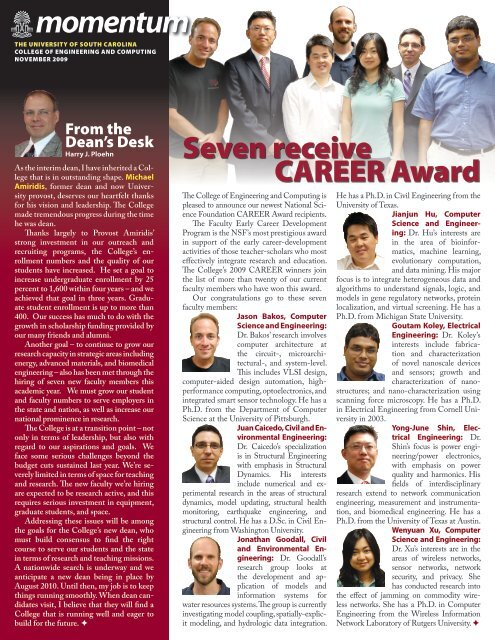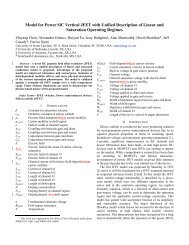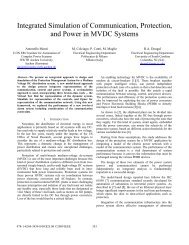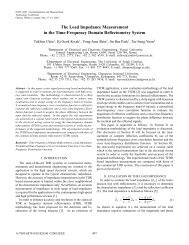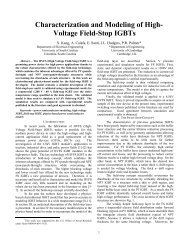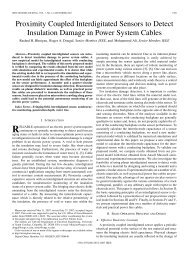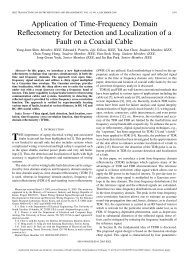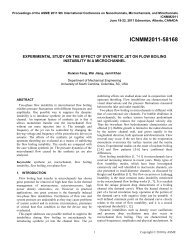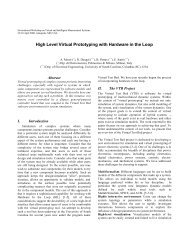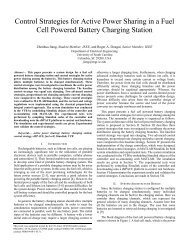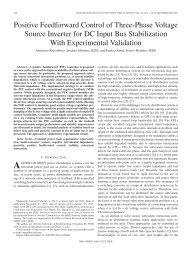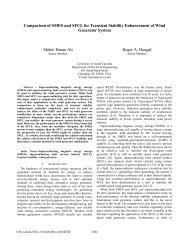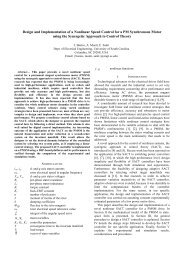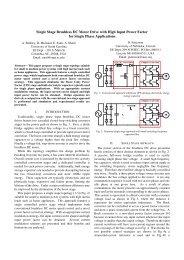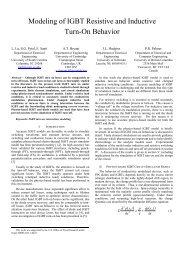November 2009 - College of Engineering and Computing ...
November 2009 - College of Engineering and Computing ...
November 2009 - College of Engineering and Computing ...
Create successful ePaper yourself
Turn your PDF publications into a flip-book with our unique Google optimized e-Paper software.
momentum<br />
the University <strong>of</strong> soUth carolina<br />
college <strong>of</strong> engineering <strong>and</strong> compUting<br />
november <strong>2009</strong><br />
from the<br />
dean’s desk<br />
Harry J. Ploehn seven<br />
As the interim dean, I have inherited a <strong>College</strong><br />
that is in outst<strong>and</strong>ing shape. Michael<br />
Amiridis, former dean <strong>and</strong> now University<br />
provost, deserves our heartfelt thanks<br />
for his vision <strong>and</strong> leadership. The <strong>College</strong><br />
made tremendous progress during the time<br />
he was dean.<br />
Thanks largely to Provost Amiridis’<br />
strong investment in our outreach <strong>and</strong><br />
recruiting programs, the <strong>College</strong>’s enrollment<br />
numbers <strong>and</strong> the quality <strong>of</strong> our<br />
students have increased. He set a goal to<br />
increase undergraduate enrollment by 25<br />
percent to 1,600 within four years – <strong>and</strong> we<br />
achieved that goal in three years. Graduate<br />
student enrollment is up to more than<br />
400. Our success has much to do with the<br />
growth in scholarship funding provided by<br />
our many friends <strong>and</strong> alumni.<br />
Another goal – to continue to grow our<br />
research capacity in strategic areas including<br />
energy, advanced materials, <strong>and</strong> biomedical<br />
engineering – also has been met through the<br />
hiring <strong>of</strong> seven new faculty members this<br />
academic year. We must grow our student<br />
<strong>and</strong> faculty numbers to serve employers in<br />
the state <strong>and</strong> nation, as well as increase our<br />
national prominence in research.<br />
The <strong>College</strong> is at a transition point – not<br />
only in terms <strong>of</strong> leadership, but also with<br />
regard to our aspirations <strong>and</strong> goals. We<br />
face some serious challenges beyond the<br />
budget cuts sustained last year. We’re severely<br />
limited in terms <strong>of</strong> space for teaching<br />
<strong>and</strong> research. The new faculty we’re hiring<br />
are expected to be research active, <strong>and</strong> this<br />
requires serious investment in equipment,<br />
graduate students, <strong>and</strong> space.<br />
Addressing these issues will be among<br />
the goals for the <strong>College</strong>’s new dean, who<br />
must build consensus to find the right<br />
course to serve our students <strong>and</strong> the state<br />
in terms <strong>of</strong> research <strong>and</strong> teaching missions.<br />
A nationwide search is underway <strong>and</strong> we<br />
anticipate a new dean being in place by<br />
August 2010. Until then, my job is to keep<br />
things running smoothly. When dean c<strong>and</strong>idates<br />
visit, I believe that they will find a<br />
<strong>College</strong> that is running well <strong>and</strong> eager to<br />
build for the future. F<br />
receive<br />
career award<br />
The <strong>College</strong> <strong>of</strong> <strong>Engineering</strong> <strong>and</strong> <strong>Computing</strong> is<br />
pleased to announce our newest National Science<br />
Foundation CAREER Award recipients.<br />
The Faculty Early Career Development<br />
Program is the NSF’s most prestigious award<br />
in support <strong>of</strong> the early career-development<br />
activities <strong>of</strong> those teacher-scholars who most<br />
effectively integrate research <strong>and</strong> education.<br />
The <strong>College</strong>’s <strong>2009</strong> CAREER winners join<br />
the list <strong>of</strong> more than twenty <strong>of</strong> our current<br />
faculty members who have won this award.<br />
Our congratulations go to these seven<br />
faculty members:<br />
Jason Bakos, Computer<br />
Science <strong>and</strong> <strong>Engineering</strong>:<br />
Dr. Bakos’ research involves<br />
computer architecture at<br />
the circuit-, microarchitectural-,<br />
<strong>and</strong> system-level.<br />
This includes VLSI design,<br />
computer-aided design automation, highperformance<br />
computing, optoelectronics, <strong>and</strong><br />
integrated smart sensor technology. He has a<br />
Ph.D. from the Department <strong>of</strong> Computer<br />
Science at the University <strong>of</strong> Pittsburgh.<br />
Juan Caicedo, Civil <strong>and</strong> Environmental<br />
<strong>Engineering</strong>:<br />
Dr. Caicedo’s specialization<br />
is in Structural <strong>Engineering</strong><br />
with emphasis in Structural<br />
Dynamics. His interests<br />
include numerical <strong>and</strong> experimental<br />
research in the areas <strong>of</strong> structural<br />
dynamics, model updating, structural health<br />
monitoring, earthquake engineering, <strong>and</strong><br />
structural control. He has a D.Sc. in Civil <strong>Engineering</strong><br />
from Washington University.<br />
Jonathan Goodall, Civil<br />
<strong>and</strong> Environmental <strong>Engineering</strong>:<br />
Dr. Goodall’s<br />
research group looks at<br />
the development <strong>and</strong> application<br />
<strong>of</strong> models <strong>and</strong><br />
information systems for<br />
water resources systems. The group is currently<br />
investigating model coupling, spatially-explicit<br />
modeling, <strong>and</strong> hydrologic data integration.<br />
He has a Ph.D. in Civil <strong>Engineering</strong> from the<br />
University <strong>of</strong> Texas.<br />
Jianjun Hu, Computer<br />
Science <strong>and</strong> <strong>Engineering</strong>:<br />
Dr. Hu’s interests are<br />
in the area <strong>of</strong> bioinformatics,<br />
machine learning,<br />
evolutionary computation,<br />
<strong>and</strong> data mining. His major<br />
focus is to integrate heterogeneous data <strong>and</strong><br />
algorithms to underst<strong>and</strong> signals, logic, <strong>and</strong><br />
models in gene regulatory networks, protein<br />
localization, <strong>and</strong> virtual screening. He has a<br />
Ph.D. from Michigan State University.<br />
Goutam Koley, Electrical<br />
<strong>Engineering</strong>: Dr. Koley’s<br />
interests include fabrication<br />
<strong>and</strong> characterization<br />
<strong>of</strong> novel nanoscale devices<br />
<strong>and</strong> sensors; growth <strong>and</strong><br />
characterization <strong>of</strong> nanostructures;<br />
<strong>and</strong> nano-characterization using<br />
scanning force microscopy. He has a Ph.D.<br />
in Electrical <strong>Engineering</strong> from Cornell University<br />
in 2003.<br />
Yong-June Shin, Electrical<br />
<strong>Engineering</strong>: Dr.<br />
Shin’s focus is power engineering/power<br />
electronics,<br />
with emphasis on power<br />
quality <strong>and</strong> harmonics. His<br />
fields <strong>of</strong> interdisciplinary<br />
research extend to network communication<br />
engineering, measurement <strong>and</strong> instrumentation,<br />
<strong>and</strong> biomedical engineering. He has a<br />
Ph.D. from the University <strong>of</strong> Texas at Austin.<br />
Wenyuan Xu, Computer<br />
Science <strong>and</strong> <strong>Engineering</strong>:<br />
Dr. Xu’s interests are in the<br />
areas <strong>of</strong> wireless networks,<br />
sensor networks, network<br />
security, <strong>and</strong> privacy. She<br />
has conducted research into<br />
the effect <strong>of</strong> jamming on commodity wireless<br />
networks. She has a Ph.D. in Computer<br />
<strong>Engineering</strong> from the Wireless Information<br />
Network Laboratory <strong>of</strong> Rutgers University. F
c h e m i c a l<br />
engineering<br />
message<br />
from the<br />
chair<br />
Michael A. Matthews<br />
Greetings to all <strong>of</strong> our readers! This edition<br />
<strong>of</strong> the newsletter coincides with the<br />
Thanksgiving season, <strong>and</strong> so from everyone<br />
in the Department <strong>of</strong> Chemical <strong>Engineering</strong>,<br />
best wishes for a happy holiday!<br />
Thank you for reading this edition <strong>and</strong> for<br />
your interest <strong>and</strong> support <strong>of</strong> our students<br />
<strong>and</strong> staff.<br />
We have many things to celebrate<br />
this season. First <strong>of</strong> all, we enjoyed another<br />
strong incoming class with over 50<br />
new freshman <strong>and</strong> transfer students,<br />
bringing our undergraduate Chemical <strong>Engineering</strong><br />
program to about 165 students.<br />
We also admitted over 20 new graduate<br />
students <strong>and</strong> are at an all-time high<br />
<strong>of</strong> 78 graduate students. We continue to<br />
support the Biomedical <strong>Engineering</strong> program<br />
through both teaching <strong>and</strong> research,<br />
<strong>and</strong> so we are also benefitting from the<br />
over 50 new freshman in this program<br />
as well. Despite the difficult economy <strong>and</strong><br />
slow hiring season, our graduates have<br />
found employment with companies such<br />
as ExxonMobil, Westinghouse Nuclear,<br />
<strong>and</strong> Freeport-McMoran. It appears that<br />
the job market will improve for the coming<br />
year.<br />
The faculty continue to grow in size<br />
<strong>and</strong> reputation as well. In the spring, we<br />
will welcome Associate Pr<strong>of</strong>essor Xiao-<br />
Dong Zhou, who will join us after several<br />
years at Pacific Northwest Lab in Richl<strong>and</strong>,<br />
Washington. His area <strong>of</strong> expertise<br />
is materials for solid oxide fuel cells, <strong>and</strong><br />
you will be reading more about Dr. Zhou<br />
in a future issue <strong>of</strong> Momentum. Other<br />
faculty accomplishments are listed in this<br />
newsletter, as well as in our annual report,<br />
which can be seen online at www.che.<br />
sc.edu.<br />
Finally, just a note about Pr<strong>of</strong>essor<br />
Vince Van Brunt, who has been teacher,<br />
mentor, <strong>and</strong> coach to so many <strong>of</strong> our students<br />
since 1974. Vince <strong>of</strong>ficially retired<br />
on September 20, <strong>2009</strong>. He continues to<br />
teach <strong>and</strong> direct student projects, <strong>and</strong> is a<br />
great benefit to all <strong>of</strong> us. There will be more<br />
to come about Vince in future editions. F<br />
Associate Pr<strong>of</strong>essor Dr. Ed Gatzke was on<br />
sabbatical at the University <strong>of</strong> Stuttgart<br />
from May 2008 to July <strong>2009</strong>. He worked<br />
with researchers Dr. Frank Allgower, the<br />
leading process control expert in Germany,<br />
<strong>and</strong> Dr. Ulrich Nieken, whose team investigates<br />
various reaction systems.<br />
In Germany, Dr. Gatzke attended five<br />
European conferences <strong>and</strong> gave invited<br />
lectures at four universities. He also participated<br />
in conferences, attended seminars,<br />
Associate Pr<strong>of</strong>essor Dr. Chris Williams was<br />
in China from May to June. It was the first <strong>of</strong><br />
three annual month-long visits he will make<br />
to the Dalian University <strong>of</strong> Technology, a<br />
multi-disciplinary university <strong>of</strong> science <strong>and</strong><br />
technology located in Dalian, a coastal city.<br />
The trips are part <strong>of</strong> Dr. Williams’<br />
<strong>2009</strong>-2011 appointment as Seasky Visiting<br />
Pr<strong>of</strong>essor to the Dalian Department <strong>of</strong><br />
Chemical <strong>Engineering</strong>. The appointment<br />
provides an all-expenses paid opportunity<br />
The twelfth session <strong>of</strong> the Department’s NSF-funded<br />
Research Experience for Undergraduates (REU) will<br />
be held May 24 through July 31, 2010.<br />
Participants will have the opportunity to conduct<br />
research focused on sustainable energy. Topics will<br />
include catalysis, batteries <strong>and</strong> fuel cells, hydrogen production<br />
<strong>and</strong> storage, <strong>and</strong> polymers <strong>and</strong> nanoscience. At<br />
the conclusion <strong>of</strong> the ten-week research period – which<br />
will also feature seminars, workshops, <strong>and</strong> visits to<br />
local industries – students will present their findings at<br />
a symposium in the Swearingen <strong>Engineering</strong> Center.<br />
For application <strong>and</strong> other information, visit www.<br />
che.sc.edu/centers/reu. F<br />
sabbatical<br />
in germany<br />
provides wealth<br />
<strong>of</strong> experience<br />
<strong>and</strong> met with well-known academics from<br />
around the world.<br />
Dr. Gatzke also visited the Fraunh<strong>of</strong>er<br />
Institute for Solar Energy in Freiburg, <strong>and</strong><br />
developed his own s<strong>of</strong>tware codes for a variety<br />
<strong>of</strong> applications.<br />
Support for the sabbatical was provided<br />
by the Alex<strong>and</strong>er Von Humboldt<br />
Foundation, <strong>and</strong> by an NSF Career Award<br />
supplement from the International Research<br />
<strong>and</strong> Education in <strong>Engineering</strong>. F<br />
faculty member’s<br />
travels build strong ties<br />
twelfth session <strong>of</strong><br />
reU set for 2010<br />
PAGE 2 • noVEMBEr <strong>2009</strong> • momentum • college <strong>of</strong> engineering <strong>and</strong> computing<br />
for collaboration in catalysis<br />
projects.<br />
In addition to furthering<br />
this area <strong>of</strong> research,<br />
Dr. Williams is able to<br />
foster working relationships with Dalian<br />
faculty <strong>and</strong> students. These ties benefit<br />
USC by enhancing opportunities for future<br />
joint research projects, graduate student<br />
recruitment, <strong>and</strong> exchange programs. F<br />
Graduate students Amy Beaird <strong>and</strong><br />
Jennifer Patterson with their ‘<strong>Engineering</strong><br />
Cake” which was entered in<br />
the Ace <strong>of</strong> Cakes competition at USC<br />
judged by Duff Goldman <strong>of</strong> the Food<br />
Network. See<br />
“Photo Gallery”<br />
at www.<br />
cec.<br />
sc.<br />
edu<br />
for<br />
more<br />
photos.
Students benefit from co-ops,<br />
internships, REU programs<br />
Several chemical engineering undergraduates<br />
are benefitting from co-ops, internships,<br />
<strong>and</strong> Research Experience for Undergraduates<br />
(REU) programs provided by industry<br />
<strong>and</strong> government.<br />
Kimberly Hamm is doing a<br />
year-long co-op at Duke Energy.<br />
She is spending five months at<br />
the Marshall Steam Station in<br />
Mooresville, N.C. as part <strong>of</strong> the<br />
Scrubber Chemistry Team. She<br />
will spend the remainder <strong>of</strong> the<br />
year working in Charlotte for the Environmental,<br />
Health, <strong>and</strong> Safety group.<br />
Shawn Fink is also employed in a<br />
year-long co-op. He is working with<br />
Celgard. LLC in Charlotte as a part<br />
<strong>of</strong> the Process Improvement Group<br />
in a laminator drum-fouling project<br />
<strong>and</strong> in legacy problem trials.<br />
alumni pr<strong>of</strong>ile: val ray<br />
Valton “Val” ray, who received a BS in<br />
Chemical <strong>Engineering</strong> in 1976, has served<br />
on the Department’s Industrial Advisory<br />
Board since 1991 <strong>and</strong> has been a long-time<br />
friend to his alma mater.<br />
Val is plant manager at Shaw Industries<br />
in Columbia. The company – now <strong>and</strong> in its<br />
previous incarnations as Allied Chemical,<br />
Allied Signal, <strong>and</strong> Honeywell – has funded<br />
scholarships, endowed chairs, <strong>and</strong> provided<br />
other expertise <strong>and</strong> financial assistance to<br />
the <strong>College</strong> <strong>and</strong> the department.<br />
Val also serves the community <strong>and</strong> the<br />
state as a member <strong>of</strong> the Board <strong>of</strong> Advisors<br />
<strong>of</strong> the Columbia Chamber <strong>of</strong> Commerce,<br />
<strong>and</strong> as treasurer <strong>of</strong> the S.C. Manufacturers<br />
Association.<br />
As a member <strong>of</strong> a military family, Val spent<br />
his childhood in various places. He attended<br />
high school in North Carolina, where he first<br />
Alex Fergusson completed a summer<br />
internship at the Research Triangle Institute<br />
Center <strong>of</strong> Energy Technology in Raleigh.<br />
He worked on a liquid carbon capture project<br />
with Paige Presler, a USC graduate who<br />
received an MS degree in Chemical <strong>Engineering</strong><br />
in 2004.<br />
Colin Eaker spent the summer in<br />
Freiburg, Germany, doing fuel cell research<br />
at the Fraunh<strong>of</strong>er Institute for Solar Energy.<br />
Meghan Clardy <strong>and</strong> Kristin Smith participated<br />
in the Summer REU program at<br />
the University <strong>of</strong> Puerto Rico, Mayaguez.<br />
They were involved in the study <strong>of</strong> “Post-<br />
Synthesis Modification <strong>of</strong> Flexible Nanoporous<br />
Adsorbents.”<br />
Caleb Gustafson managed both a summer<br />
internship at Savannah River Site <strong>and</strong> teaching<br />
marching b<strong>and</strong> to high school students. F<br />
learned about USC from<br />
his math teacher <strong>and</strong> was<br />
encouraged to apply.<br />
As a student here,<br />
Val found Dr. Joe<br />
Gibbons especially instrumental in helping<br />
him relate fluid mechanics to manufacturing,<br />
<strong>and</strong> this knowledge served Val well in his first<br />
job at Allied Chemical in Baltimore. He also<br />
recalls that he <strong>and</strong> other students shared an<br />
ambition to receive a grade greater than 35<br />
on Dr. Gibbons’ exams.<br />
Val is one <strong>of</strong> many Gamecocks in his<br />
family. His brother, Timothy Ray, is a USC Civil<br />
<strong>Engineering</strong> graduate, <strong>and</strong> his wife S<strong>and</strong>ra,<br />
an elementary school teacher, is a graduate<br />
<strong>of</strong> the USC School <strong>of</strong> Law. Continuing the<br />
family tradition, Val’s daughter, Caroline, is a<br />
senior in the Moore School <strong>of</strong> Business. F<br />
ritter appointed Weisiger pr<strong>of</strong>essor<br />
Dr. Jim ritter has been named the L.S. Weisiger<br />
Pr<strong>of</strong>essor <strong>of</strong> <strong>Engineering</strong>. This endowed<br />
chair appointment is for a five-year term.<br />
Dr. Ritter, a member <strong>of</strong> the Smart Medical<br />
Systems <strong>and</strong> Technology Team, has also<br />
received funding from the National Space<br />
Biomedical Research Institute for a four-year,<br />
$1.8 million project entitled, “Development<br />
<strong>of</strong> Pressure Swing Adsorption Technology for<br />
Spaceflight Medical Oxygen Concentrators.”<br />
He will partner on the project with V<strong>and</strong>erbilt<br />
University, the NASA Marshall Space Flight<br />
Center (MSFC), <strong>and</strong> SeQual, a<br />
San Diego-based company<br />
that produces medical oxygen<br />
concentrators. Dr. Ritter <strong>and</strong> his team will study<br />
these concentrators for space applications.<br />
Dr. Ritter has recently been awarded four<br />
other research grants.<br />
The NASA MSFC, which has been funding<br />
his group for the past five years, is funding<br />
“Analysis <strong>of</strong> Engineered Structured Sorbent<br />
Systems for the Next Generation Atmosphere<br />
Revitalization System.” Another project, “Pres-<br />
c h e m i c a l<br />
engineering<br />
achievements<br />
Dr. Esmaiel Jabbari has been granted<br />
tenure. He also has been appointed to the<br />
Advisory Board <strong>of</strong> International Conferences<br />
on Materials <strong>and</strong> Technologies.<br />
Dr. John Monnier, Principal Investigator<br />
(PI), with Co-PI Dr. Chris Williams, has<br />
been awarded a $330,000 grant by NSF for<br />
the project “Collaborative Research: Preparation,<br />
Characterization, <strong>and</strong> Evaluation<br />
<strong>of</strong> Biometallic Catalysts Using Electroless<br />
Deposition Methods for the Selective Oxidation<br />
<strong>of</strong> Biomass-Related Alcohols.”<br />
Dr. Andreas Heyden was granted<br />
$300,000 by NSF for “Multiscale Modeling<br />
<strong>of</strong> Bifunctional Catalysts for the Water-Gas-<br />
Shift Reaction.”<br />
Ph.D. graduate Venkat Subramanian has<br />
accepted a position as Associate Pr<strong>of</strong>essor in<br />
the Department <strong>of</strong> Energy, Environmental,<br />
<strong>and</strong> Chemical <strong>Engineering</strong> at Washington<br />
University in St. Louis.<br />
Graduate student Jan omar Mangual was<br />
chosen to participate, with all-expenses<br />
paid, in the Building <strong>Engineering</strong> <strong>and</strong> Science<br />
Talent (BEST) Symposium, hosted by<br />
The Dow Chemical Company in Midl<strong>and</strong>,<br />
Michigan in September. The event gives<br />
students an opportunity to explore careers<br />
in the chemical industry <strong>and</strong> showcase their<br />
abilities by presenting their scientific work.<br />
Dr. John Weidner is the recipient <strong>of</strong><br />
a $50,373 grant from the S.C. EPSCOR/<br />
National Center for Research Resources/<br />
NIH for “S.C. EPSCOR/IDEA Postdoctoral<br />
Academic Career Development Program<br />
(PACD) – Dr. John Staser.”<br />
Faraday Technologies/U.S. Air Force has<br />
funded Dr. Branko Popov’s $50,000<br />
project “Development <strong>of</strong> a Diagnostic<br />
Model for Hydrogen Permeation through<br />
High-Strength Alloys Under Corroding<br />
Conditions.”<br />
Dr. ralph White has received $30,000 from<br />
Quallion LLC/DOD for his study <strong>of</strong> “STTR –<br />
Lithium Ion Cell <strong>and</strong> Battery Life Modeling<br />
to Encompass Wider Life Parameters.” F<br />
sure Swing Adsorption Cycle Modeling for<br />
Medical Oxygen Concentrators,” is supported<br />
by DARPA with SeQual Technologies. The<br />
Pacific Northwest National Laboratory <strong>and</strong><br />
the U.S. Department <strong>of</strong> Energy are sponsoring<br />
“Development <strong>of</strong> New Adsorption Cycles<br />
for Xenon Concentration from Air.” And NSF<br />
is funding a three-year effort entitled, “Complex<br />
Hydrides <strong>of</strong> Lithium, Aluminum <strong>and</strong><br />
Boron for Hydrogen Storage.” F
civil <strong>and</strong> environmental<br />
engineering<br />
message<br />
from the<br />
chair<br />
David Waugh<br />
The fall semester is underway <strong>and</strong> the<br />
spirit <strong>of</strong> renewal is among us, except for<br />
my picture still heading this column. The<br />
search for a new chair was not successful<br />
as <strong>of</strong> this writing; one more c<strong>and</strong>idate is<br />
to interview.<br />
Dean Michael Amiridis being named<br />
Provost <strong>of</strong> the University is a mark not<br />
only <strong>of</strong> his remarkable talents but also<br />
recognition <strong>of</strong> the remarkable success <strong>of</strong><br />
the <strong>College</strong>.<br />
The 2008-<strong>2009</strong> year saw the department<br />
achieve a significant increase in external<br />
funding. This issue <strong>of</strong> Momentum documents<br />
some <strong>of</strong> the larger awards, but there<br />
were others <strong>of</strong> significance, <strong>and</strong> funding<br />
level is not the only measure <strong>of</strong> merit. If<br />
the number <strong>of</strong> proposals under preparation<br />
is any indicator, the best is yet to come.<br />
Of special note is the fact that this Department<br />
alone had two NSF CAREER award<br />
winners this year; many large colleges do<br />
not exceed that number for their whole<br />
college. And that adds to the three previous<br />
winners in this department.<br />
New students in the <strong>College</strong> this Fall<br />
included 104 for our department, second<br />
only to Mechanical <strong>Engineering</strong> at<br />
108. Due to larger than usual graduating<br />
classes, the total undergraduate enrollment<br />
is up only marginally, but the wave<br />
is coming. Graduate enrollment continues<br />
to escalate.<br />
The previously mentioned strain on<br />
faculty, staff, <strong>and</strong> facilities continues,<br />
but it is easy to be enthusiastic about the<br />
future <strong>of</strong> the Department.<br />
I enjoyed seeing several <strong>of</strong> you at the<br />
big celebration on May 16. Andy Card<br />
(CE Class <strong>of</strong> 1971), the featured speaker,<br />
was a reminder <strong>of</strong> the many, <strong>and</strong> varied,<br />
paths taken by those with a Civil <strong>Engineering</strong><br />
education.<br />
Dr. Michael Meadows’ senior design<br />
class has been chosen as the sole university<br />
test bed for SITEOPS, a sophisticated<br />
site development program. Students in<br />
this class continue to be critiqued by<br />
teams <strong>of</strong> practitioners as they work on real<br />
projects. Evaluation comments are very<br />
CEE CHAIr continued on page 5<br />
Dr. richard ray has returned from his sabbatical<br />
<strong>and</strong> Fulbright research in Hungary.<br />
He was appointed the first visiting pr<strong>of</strong>essor<br />
at Szechenyi University in Gyor, a<br />
city located in northwestern Hungary about<br />
halfway between Budapest <strong>and</strong> Vienna,<br />
Austria. His work at Szechenyi included<br />
field <strong>and</strong> laboratory testing, as well as computer<br />
modeling.<br />
“There is a real influx <strong>of</strong> construction<br />
work in Hungary, mainly infrastructure with<br />
highways, bridges, <strong>and</strong> tunnels,” said Dr.<br />
Ray. “European Union funding has helped<br />
to develop extended regional transportation<br />
systems in Central Europe, linking Western<br />
Europe with Russia, Eastern Europe, <strong>and</strong><br />
Western Asia.”<br />
Highway bridge foundation designs were<br />
evaluated for several highways crossing the<br />
Danube <strong>and</strong> Tissa rivers. Geotechnical conditions<br />
in Hungary are different than much <strong>of</strong><br />
Western Europe, so firms are still figuring out<br />
the best designs <strong>and</strong> construction methods.<br />
During Dr. Ray’s one-year stay at Szechenyi,<br />
more than 30 pile load tests for bridge<br />
construction were conducted by the Geotechnical<br />
Group, headed by Robert Szepeshazy. In<br />
addition, laboratory evaluations <strong>of</strong> soils from<br />
these sites <strong>and</strong> others around the country have<br />
been conducted <strong>and</strong> cataloged. Data from<br />
new assistant pr<strong>of</strong>essor<br />
gets nsf funding<br />
In what is likely a record within the <strong>College</strong> <strong>of</strong> <strong>Engineering</strong> <strong>and</strong> <strong>Computing</strong>,<br />
Dr. navid Saleh succeeded in getting a major proposal funded by the<br />
National Science Foundation within the first six months <strong>of</strong> his hire.<br />
Dr. Saleh, who joined the Department <strong>of</strong> Civil <strong>and</strong> Environmental<br />
<strong>Engineering</strong> as an assistant pr<strong>of</strong>essor earlier this year, submitted his<br />
proposal in a highly competitive group <strong>of</strong> mostly well-established<br />
researchers. It was hardly the place for a new, young faculty member,<br />
<strong>and</strong> yet his was among the highest-ranked proposals. The two-year<br />
grant – totaling more than $399,000 – looks at how nanoparticles behave<br />
in the natural environment, including their possible toxicity.<br />
Dr. Saleh received MS <strong>and</strong> Ph.D. degrees from Carnegie Mellon<br />
University. He credits his post-doctoral training at Yale University for his<br />
funding success.<br />
“Also, an aggressive attitude in going after the funding immediately<br />
<strong>and</strong> finding the right people to work with is crucial,” he said. “The academic<br />
world today is interdisciplinary, <strong>and</strong> you cannot succeed alone.” F<br />
PAGE 4 • noVEMBEr <strong>2009</strong> • momentum • college <strong>of</strong> engineering <strong>and</strong> computing<br />
geotechnical<br />
engineering,<br />
hungarian style<br />
over 300 consolidation tests <strong>and</strong> 150 triaxial<br />
tests are now part <strong>of</strong> the soil performance<br />
database used by the group.<br />
A consortium consisting <strong>of</strong> the European<br />
Union, the Hungarian Transportation Ministry,<br />
<strong>and</strong> private design <strong>and</strong> construction firms<br />
funded the research as part <strong>of</strong> a four-year<br />
400-million Forint ($2.2 million) study. In addition<br />
to the field testing, extensive laboratory<br />
testing <strong>and</strong> computer modeling is involved.<br />
Dr. Ray, with the help <strong>of</strong> three Ph.D. students,<br />
performed finite element studies <strong>of</strong><br />
bridge foundations <strong>and</strong> abutments based on<br />
the field <strong>and</strong> laboratory data. Results <strong>of</strong> the<br />
modeling study helped bridge designers to determine<br />
the necessary foundation support for<br />
their alternate designs. Since new foundation<br />
construction methods are being introduced<br />
throughout Europe, baseline analyses become<br />
a vital starting point for the design engineer.<br />
“With a new construction technology,<br />
design engineers do not have much performance<br />
history to rely on,” Dr. Ray said. “They<br />
have to look toward the field testing results<br />
<strong>and</strong> the extensive modeling we performed.”<br />
Construction will continue on transportation<br />
infrastructure in Hungary for at<br />
least another ten years. Bridge <strong>and</strong> tunnel<br />
replacements will take up a large portion <strong>of</strong><br />
that work. F
Students in the News<br />
Angel Ari Perez, a Ph.D. student in Geotechnical<br />
<strong>Engineering</strong> who is working with<br />
Dr. Charles Pierce, has received the <strong>2009</strong>-<br />
2010 GK-K-12 Fellowship. Ari will spend<br />
two days each week assisting in a sixth-, seventh-,<br />
or eighth-grade science classroom, <strong>and</strong><br />
five hours each week outside the classroom<br />
for planning.<br />
Jesé Mangual, Angel Ari Perez, <strong>and</strong> Luis<br />
Solari are recipients <strong>of</strong> a South East Alliance<br />
for Graduate Education <strong>and</strong> the Pr<strong>of</strong>essoriate<br />
(SEAGEP) Fellowship for <strong>2009</strong>-2010. This<br />
fellowship allows the recipient to gain knowledge<br />
in the teaching field by funding travel to<br />
conferences <strong>and</strong> development seminars. The<br />
goal <strong>of</strong> the fellowship is to encourage recipients<br />
to become faculty members at colleges<br />
<strong>and</strong> universities in this country.<br />
The University was well represented this<br />
summer at the <strong>2009</strong> Asia-Pacific Summer<br />
School on Smart Structures Technology<br />
(APSS) by Glen Wieger, a doctoral student in<br />
the structures group who works with Dr. Juan<br />
M. Caicedo. The program consisted <strong>of</strong> fortyfive<br />
<strong>of</strong> the top graduate students from around<br />
the globe, from such prestigious international<br />
universities as the University <strong>of</strong> Tokyo, Tongji<br />
University, KAIST, <strong>and</strong> the University <strong>of</strong><br />
Pavia. The goal <strong>of</strong> the event was to enhance<br />
students’ underst<strong>and</strong>ing <strong>of</strong> cutting-edge,<br />
cross-disciplinary technology in the smart<br />
structures field <strong>and</strong> to develop cross-cultural<br />
underst<strong>and</strong>ing for future cooperation. Glen<br />
was one <strong>of</strong> the graduate students selected<br />
from the highly competitive application process.<br />
The three-week APSS course involved<br />
intense lectures by world-renowned researchers<br />
from academia <strong>and</strong> private industry as<br />
well as student competitions that required<br />
the application <strong>of</strong> the material learned on the<br />
lectures. The two main competitions consisted<br />
<strong>of</strong> doing analysis on a full-scale in-service<br />
bridge using wireless sensors <strong>and</strong> developing<br />
control algorithms to keep a double inverted<br />
pendulum at equilibrium. Glen’s research<br />
team tied for first place in the competition.<br />
A tour <strong>of</strong> Chicago’s skyscrapers, a visit to the<br />
City Museum in St. Louis, <strong>and</strong> a dinner with<br />
an Amish family were part <strong>of</strong> the cultural experiences<br />
<strong>of</strong> the program. This year’s program<br />
was hosted by the University <strong>of</strong> Illinois at<br />
Urbana-Champaign <strong>and</strong> will be returning to<br />
the University <strong>of</strong> Tokyo in 2010. Dr. Caicedo<br />
was invited to the summer school as a lecturer<br />
on modeling <strong>and</strong> system identification.<br />
Joshua Atria, an undergraduate studying<br />
Civil <strong>Engineering</strong>, participated in the<br />
University’s Supplemental Instructor Program.<br />
Joshua was chosen to apply for this position<br />
based on his outst<strong>and</strong>ing academic performance.<br />
As a participant in the program, he<br />
is required to attend Statics class, take notes,<br />
<strong>and</strong> complete class reading <strong>and</strong> homework assignments<br />
(again). The Statics SI sessions are<br />
<strong>of</strong>fered three times each week <strong>and</strong> are open to<br />
students, free <strong>of</strong> charge, who feel they need<br />
additional help with course material.<br />
Walter E. rowe Student Chapter ASCE<br />
Officers for <strong>2009</strong>-2010: Stephen Avila,<br />
president; Marshall Walker, vice president;<br />
Greg Moore, treasurer; Megan Easterlin,<br />
secretary; Amy Killoy <strong>and</strong> Megan Bell, public<br />
relations. For information on sponsorship,<br />
upcoming events <strong>and</strong> contact information,<br />
please see student organizations at www.cec.<br />
sc.edu. F<br />
alumni pr<strong>of</strong>ile: chip stehmeyer<br />
Edward Henry “Chip” Stehmeyer Jr.<br />
earned his Bachelor <strong>of</strong> Science degree in<br />
1974. As an undergraduate, he served as<br />
President for the Walter E. Rowe Student<br />
Chapter <strong>of</strong> ASCE. He continued his engineering<br />
studies at USC <strong>and</strong> became Dr. James<br />
radziminski’s first graduate student. Chip<br />
finished the Masters <strong>of</strong> <strong>Engineering</strong> degree<br />
in 1975.<br />
During thirty-one years <strong>of</strong> federal service,<br />
Chip worked with the Naval Facilities <strong>Engineering</strong><br />
Comm<strong>and</strong> as Chief Engineer <strong>and</strong><br />
Director <strong>of</strong> Capital Improvements, Southern<br />
Division. He served as Director <strong>of</strong> Project<br />
Development, Design, <strong>and</strong> Constructions <strong>of</strong><br />
approximately $800 million annually for the<br />
Navy, Marine Corps, Air Force, <strong>and</strong> other Department<br />
<strong>of</strong> Defense Shore Facilities. In 2004,<br />
Chip went to work for the Center for Disease<br />
Control as Director <strong>of</strong> Buildings <strong>and</strong> Facilities,<br />
where he oversaw planning, design,<br />
<strong>and</strong> construction <strong>of</strong> a $1.5 billion recapital-<br />
ization program for CDC’s<br />
laboratories <strong>and</strong> scientific<br />
research facilities.<br />
Chip has received<br />
much recognition during his career,<br />
including being named the Naval Facilities<br />
<strong>Engineering</strong> Comm<strong>and</strong>’s Engineer <strong>of</strong> the<br />
Year in 1987. He also was chosen as one<br />
<strong>of</strong> the top ten engineers in Federal Service<br />
by the National Society <strong>of</strong> Pr<strong>of</strong>essional<br />
Engineers. He was decorated with the<br />
Department <strong>of</strong> the Navy’s Meritorious Civil<br />
Service Award in 1997, the Department <strong>of</strong><br />
the Navy’s Superior Civilian Service Award in<br />
2004, <strong>and</strong> the State <strong>of</strong> South Carolina’s Order<br />
<strong>of</strong> the Silver Crescent in 2004.<br />
Today, Chip works as a Marine Structures<br />
Engineer with Collins Engineers Inc., an<br />
ENR Top 500 Design Firm that provides<br />
services in the transportation, marine, <strong>and</strong><br />
construction sector. He lives <strong>and</strong> works in<br />
Charleston, SC. F<br />
civil <strong>and</strong> environmental<br />
engineering<br />
achievements<br />
Dr. M. Hanif Chaudhry is the recipient <strong>of</strong><br />
a $400,000 NSF supplement to the ongoing<br />
$2.5 million PIRE project research on Levee<br />
Breaches. Co-PI is Dr. Jasim Imran.<br />
Dr. Yeomin Yoon has been named Associate<br />
Editor for the journal Water Science <strong>and</strong><br />
Technology.<br />
Dr. Sarah Gassman has agreed to serve as<br />
the Graduate Director for the Department.<br />
Welcome<br />
Dr. Walter F. Silva has joined us for one year<br />
as a visiting pr<strong>of</strong>essor (he will be leaving in<br />
December <strong>2009</strong>). He is on sabbatical from<br />
the Department <strong>of</strong> <strong>Engineering</strong> Science<br />
<strong>and</strong> Materials at the University <strong>of</strong> Puerto<br />
Rico in Mayaguez (UPR-M).<br />
Jianguo Yu has joined us as a Research Assistant<br />
Pr<strong>of</strong>essor from the Department <strong>of</strong><br />
Mechanical <strong>and</strong> Aeronautical <strong>Engineering</strong><br />
at Western Michigan University.<br />
seminar series<br />
Civil <strong>and</strong> Environmental <strong>Engineering</strong><br />
proudly presents Fall <strong>2009</strong> Seminar<br />
Series. Open to Alumni, Industry <strong>and</strong><br />
Friends <strong>of</strong> the Department. Fridays, 3:15 to<br />
4:15 pm, 300 Main, Room C213<br />
Call 803.777.9482 to reserve your spot. 14<br />
Lectures. For more information please see<br />
www.ce.sc.edu (announcements). nov/<br />
Dec Topics: Transportation, Nanoelectronics<br />
<strong>and</strong> Environmental.<br />
CEE CHAIr from page 4<br />
tough, but our students are the beneficiaries<br />
<strong>of</strong> years <strong>of</strong> engineering experience.<br />
As always, we love to show <strong>of</strong>f, so stop<br />
by <strong>and</strong> let us give you a tour <strong>of</strong> the Department.<br />
F<br />
ce enrollment<br />
Undergrads Grads<br />
Spring 2008 242 49<br />
Fall 2008 302 48<br />
Spring <strong>2009</strong> 269 56<br />
Fall <strong>2009</strong> 304 64<br />
university <strong>of</strong> south carolina • columbia, south carolina 29208 • noVEMBEr <strong>2009</strong> • PAGE 5
co m p u ter science<br />
<strong>and</strong> engineering<br />
message<br />
from the<br />
chair<br />
Michael Huhns<br />
It used to be said that the hallmark <strong>of</strong> a<br />
great university was a great library, <strong>and</strong><br />
rightly so. Scholarship – that is, research<br />
<strong>and</strong> education – depends on information,<br />
<strong>and</strong> the library was the place to find it.<br />
Today, however, students get their information<br />
via the Internet, the World<br />
Wide Web, <strong>and</strong> Google. The libraries <strong>of</strong> the<br />
world are now online <strong>and</strong> accessible from<br />
wherever you have a laptop or an iPhone.<br />
B<strong>and</strong>width, computer access, <strong>and</strong> a good<br />
search engine have now replaced physical<br />
libraries as the necessity for scholarship.<br />
Scholarship requires not only the ability<br />
to access existing information, but also the<br />
ability to create new information from old.<br />
<strong>Computing</strong> has become essential for creating<br />
new information. This is true in all disciplines<br />
<strong>and</strong> across the entire spectrum <strong>of</strong><br />
modern science. For example, mapping genomes<br />
<strong>and</strong> determining the proteins they<br />
produce are more computational problems<br />
than biological problems; creating many<br />
Hollywood movies cannot be done without<br />
computer graphics <strong>and</strong> animation; decoding<br />
ancient languages from fragments<br />
<strong>of</strong> text scratched onto stone tablets is more<br />
a problem <strong>of</strong> information theory than <strong>of</strong><br />
linguistics; <strong>and</strong> discovering new particles<br />
in nuclear physics requires computers to<br />
trace <strong>and</strong> sort among the nuclear interactions<br />
occurring in a supercollider.<br />
<strong>Computing</strong> involves more than just<br />
support for other scientific disciplines. At<br />
an engineering level, computers are controlling<br />
the infrastructure <strong>of</strong> the world,<br />
from the distribution <strong>of</strong> water <strong>and</strong> electricity,<br />
to the management <strong>of</strong> transportation<br />
systems <strong>and</strong> global commerce. At a<br />
scientific level, computing is an important<br />
area <strong>of</strong> research in its own right, with efforts<br />
underway to discover the scientific<br />
principles <strong>of</strong> information, computation,<br />
<strong>and</strong> knowledge.<br />
Computer science <strong>and</strong> computer engineering<br />
now are becoming the hallmarks<br />
<strong>of</strong> a great university. Your Department<br />
CSE CHAIr continued on page 5<br />
summer institute marks a first<br />
For the first time in more than a decade, an<br />
Advanced Placement Computer Science<br />
summer institute was held in South Carolina<br />
to increase the number <strong>of</strong> high school<br />
teachers with the proper credentials to teach<br />
AP computer science in the state.<br />
Teaching for the institute was done<br />
jointly by Dr. Duncan Buell, Department<br />
<strong>of</strong> Computer Science <strong>and</strong> <strong>Engineering</strong>,<br />
<strong>and</strong> richard de Paulo, a <strong>College</strong>-Boardendorsed<br />
consultant from Chesapeake,<br />
Virginia (<strong>and</strong> the only endorsed consultant<br />
in the southeast region). Fifteen teachers<br />
participated <strong>and</strong> were registered for graduate<br />
credit for the EDSE 773 course <strong>of</strong>fered by<br />
the USC <strong>College</strong> <strong>of</strong> Education. There was<br />
some early work <strong>and</strong> some late work, but<br />
the primary focus was an intense week on<br />
campus July 13-17.<br />
The fifteen participating teachers came<br />
from different high schools <strong>and</strong> ten different<br />
South Carolina districts, mostly in the<br />
Midl<strong>and</strong>s <strong>and</strong> Greenville-Spartanburg, with<br />
one teacher coming all the way from Connecticut.<br />
Normally, funding for AP summer<br />
institutes in South Carolina comes from the<br />
State Department <strong>of</strong> Education. In these<br />
trying budget times, no state funds were<br />
The Department <strong>of</strong> Computer Science <strong>and</strong><br />
<strong>Engineering</strong> played a part in two Palmetto<br />
Pillar Awards from the Information Technology<br />
Council <strong>and</strong> the Midl<strong>and</strong>s Chamber<br />
<strong>of</strong> Commerce. In the Open Source category,<br />
the award was won by the committee that<br />
organized the Palmetto Open Source S<strong>of</strong>tware<br />
Conference (POSSCON), held in<br />
summer 2008 <strong>and</strong> April <strong>2009</strong>, <strong>and</strong> scheduled<br />
for April 2010. POSSCON had<br />
more than 200 attendees this past April,<br />
<strong>and</strong> the 2010 conference, being organized<br />
again with departmental involvement on<br />
the committee, will be held in April at the<br />
Columbia Convention Center.<br />
In the Student Achievement category,<br />
Computer Science major<br />
Gary Fredericks won for s<strong>of</strong>tware<br />
he had written that assists<br />
in reading foreign language<br />
PAGE 6 • noVEMBEr <strong>2009</strong> • momentum • college <strong>of</strong> engineering <strong>and</strong> computing<br />
available, but the Consortium for Enterprise<br />
Systems Management stepped in to provide<br />
the funding for the institute. This made it<br />
possible for the teachers to attend, get both<br />
graduate credit <strong>and</strong> <strong>College</strong> Board endorsement,<br />
<strong>and</strong> secure housing in the USC West<br />
Quad, for only a nominal charge.<br />
The department has already been contacted<br />
by the State Department <strong>of</strong> Education<br />
about repeating the institute in summer<br />
2010 as part <strong>of</strong> increasing access by South<br />
Carolina students to advanced <strong>and</strong> rigorous<br />
computer science classes. F<br />
department plays role in<br />
two it awards<br />
documents. His program does an automatic<br />
translation <strong>and</strong> lookup <strong>of</strong> words to speed his<br />
reading <strong>of</strong> foreign texts. Faculty members<br />
who have taught Gary are not surprised at<br />
his winning this award; he is very creative<br />
<strong>and</strong> dedicated, <strong>and</strong> he has been involved in<br />
several activities beyond the classroom. F
obert “Chuck” Burris, Computer Science <strong>and</strong> <strong>Engineering</strong> undergraduate,<br />
won a Magellan award to study the development <strong>of</strong> Web-based textmessaging<br />
applications for behavior modification in at-risk pregnant<br />
women. His advisors are Dr. Sara Wilcox from the Department<br />
<strong>of</strong> Exercise Science <strong>and</strong> Dr. José Vidal from the Department <strong>of</strong><br />
Computer Science <strong>and</strong> <strong>Engineering</strong>.<br />
Elizabeth G. Timko, Computer<br />
Science <strong>and</strong> <strong>Engineering</strong><br />
undergraduate senior, was<br />
awarded the first John H. Fain<br />
Scholars Award. Elizabeth is<br />
working toward a bachelor’s<br />
degree in computer science,<br />
with minors in both business<br />
administration <strong>and</strong><br />
mathematics. She plans to<br />
obtain a master's degree<br />
in computer science <strong>and</strong> an<br />
MBA, with the goal <strong>of</strong> eventually<br />
starting a business in the<br />
computing industry. F<br />
Students in the News<br />
In 2001, three-time<br />
USC graduate Elizabeth<br />
“Betty”<br />
Whitaker<br />
joined the<br />
G e o r g i a<br />
Tech Research<br />
Institute (GTRI) as a research<br />
engineer in the Information Technology<br />
<strong>and</strong> Telecommunications Laboratory.<br />
GTRI is the research arm <strong>of</strong> Georgia Tech,<br />
<strong>and</strong> its research faculty provides support to<br />
the Federal government, state <strong>of</strong> Georgia,<br />
<strong>and</strong> commercial research projects. Betty’s<br />
recent research projects have included casebased<br />
reasoning in support <strong>of</strong> intelligence<br />
analysis, integrated machine learning, <strong>and</strong><br />
an artificial intelligence approach to human<br />
cultural <strong>and</strong> behavioral modeling.<br />
Now at the pinnacle <strong>of</strong> a successful engineering<br />
career, Betty looks back at the path<br />
she took <strong>and</strong> the people who helped her<br />
along the way.<br />
Betty received a BS (1973) <strong>and</strong> MS (1974)<br />
in Mathematics from USC. After several years<br />
working in computer science, she returned to<br />
USC as a graduate student in Electrical <strong>and</strong><br />
Computer <strong>Engineering</strong>. She did her master’s<br />
studies in artificial intelligence under the direction<br />
<strong>of</strong> Dr. Michael Huhns, <strong>and</strong> her Ph.D.<br />
under the direction <strong>of</strong> Pr<strong>of</strong>essor ronald<br />
Bonnell. In addition to Huhns <strong>and</strong> Bonnell,<br />
Dr. Larry Stephens served on Betty’s<br />
graduate committees <strong>and</strong> provided advice <strong>and</strong><br />
support for her research. Betty was an instructor<br />
in ECE from 1983 to 1986.<br />
alumni pr<strong>of</strong>ile:<br />
elizabeth t. Whitaker<br />
Both Huhns <strong>and</strong> Bonnell were very helpful<br />
in accommodating Betty’s nontraditional<br />
approach to continuing her education. This<br />
included part-time enrollment while working<br />
full-time, a move to Miami, completion<br />
<strong>of</strong> undergraduate engineering courses at the<br />
University <strong>of</strong> Miami, a move to Atlanta, <strong>and</strong><br />
the birth <strong>of</strong> two children.<br />
After graduate school, Betty was employed<br />
by the NCR Human Interface<br />
Technology Center <strong>and</strong> did research in artificial<br />
intelligence in support <strong>of</strong> NCR business<br />
units <strong>and</strong> in support <strong>of</strong> government research<br />
initiatives. Some <strong>of</strong> her projects included an<br />
intelligent agent approach to support Webbased<br />
continuing education <strong>and</strong> an artificial<br />
intelligence approach to military <strong>and</strong> civilian<br />
emergency medical information tools.<br />
Betty <strong>and</strong> her husb<strong>and</strong>, Paul, have two<br />
daughters, Elizabeth <strong>and</strong> Caroline. Elizabeth<br />
<strong>and</strong> her husb<strong>and</strong>, Eric Lynch, are graduate<br />
students at Georgia Tech. Elizabeth is in<br />
the Electrical <strong>and</strong> Computer <strong>Engineering</strong><br />
Ph.D. program, <strong>and</strong> Eric is in the Aerospace<br />
<strong>Engineering</strong> Ph.D. program. Caroline, a<br />
Chemical <strong>Engineering</strong> graduate <strong>of</strong> Georgia<br />
Tech, is in her second year <strong>of</strong> graduate school<br />
in the Biomedical <strong>Engineering</strong> program<br />
at the University <strong>of</strong> Virginia. Betty has<br />
engineering in her blood – her father, John<br />
Taylor, was pr<strong>of</strong>essor <strong>and</strong> chair <strong>of</strong> USC’s<br />
Department <strong>of</strong> Electrical <strong>Engineering</strong> in<br />
the 1960s. Betty <strong>and</strong> her family are proud<br />
to continue his tradition by raising the next<br />
generation <strong>of</strong> engineers. F<br />
co m p u ter science<br />
<strong>and</strong> engineering<br />
achievements<br />
Dr. Homayoun Valafar has been promoted<br />
to the rank <strong>of</strong> associate pr<strong>of</strong>essor.<br />
Dr. Jijun Tang has been promoted to the<br />
rank <strong>of</strong> associate pr<strong>of</strong>essor.<br />
Congrats to Dr. Srihari nelakuditi on<br />
being awarded $250,001 by the National<br />
Science Foundation for his project entitled,<br />
“NeTS: Small: Collaborative: Transmission<br />
Re-Ordering in Wireless Networks: Protocols<br />
<strong>and</strong> Practice.”<br />
Congrats to Dr. Stephen Fenner on being<br />
awarded $200k for three years, by NSF<br />
for his project entitled “Computational<br />
complexity from physical constraints.” He is<br />
investigating the difficulty <strong>of</strong> using a quantum<br />
computer to find the characteristics <strong>of</strong><br />
physical systems, such as the ground state<br />
energy <strong>of</strong> interacting atoms.<br />
Congrats to Dr. Duncan Buell for USC<br />
Research Foundation funding <strong>of</strong> $232,096<br />
for “Humanities Gaming Institute: Serious<br />
Games for Research <strong>and</strong> Pedagogy,” a threeweek<br />
institute on the role <strong>of</strong> immersive,<br />
interactive technologies <strong>and</strong> games within<br />
the context <strong>of</strong> the humanities, with a year<br />
<strong>of</strong> follow-up support for the twenty participants.<br />
Dr. Buell is project director; co-PIs are<br />
Pr<strong>of</strong>essor Simon Tarr <strong>and</strong> Dr. Heidi rae<br />
Cooley, USC Department <strong>of</strong> Media Arts,<br />
<strong>and</strong> Dr. r<strong>and</strong>all Cream, Department <strong>of</strong><br />
English <strong>and</strong> Center for Digital Humanities.<br />
Congrats to Dr. Jianjun Hu, Dr. Jason<br />
Bakos, <strong>and</strong> Dr. Wenyuan Xu for each<br />
receiving NSF CAREER awards. CSE had<br />
the most researchers from the <strong>College</strong> <strong>of</strong><br />
<strong>Engineering</strong> <strong>and</strong> <strong>Computing</strong> to receive this<br />
kind <strong>of</strong> award in <strong>2009</strong>; a total <strong>of</strong> ten NSF<br />
CAREER awards have been granted to CSE<br />
faculty since 1999.<br />
CSE CHAIr from page 6<br />
<strong>of</strong> Computer Science <strong>and</strong> <strong>Engineering</strong> is<br />
working hard to provide the computing <strong>and</strong><br />
information foundations for all disciplines on<br />
campus. Its students <strong>and</strong> faculty are discovering<br />
new principles <strong>of</strong> commerce, exploring<br />
the new frontiers between informatics <strong>and</strong><br />
cognitive neuroscience, making robots more<br />
efficient at exploring their environments, improving<br />
the reasoning <strong>and</strong> decision-making<br />
ability <strong>of</strong> information systems, <strong>and</strong> making<br />
the nation’s computing infrastructure more<br />
secure. With the unprecedented awarding <strong>of</strong><br />
eight NSF CAREER awards to the younger<br />
members <strong>of</strong> its faculty, the CSE Department<br />
is well positioned to continue its crucial role<br />
in ensuring that USC is a great university. F<br />
university <strong>of</strong> south carolina • columbia, south carolina 29208 • noVEMBEr <strong>2009</strong> • PAGE 7
electrical<br />
engineering<br />
message<br />
from the<br />
chair<br />
T.S. Sudarshan<br />
The Department <strong>of</strong> Electrical <strong>Engineering</strong><br />
is an exciting place to be this fall.<br />
We have added two faculty members in<br />
the new area <strong>of</strong> Photovoltaics, which<br />
straddles the existing research areas <strong>of</strong><br />
Power Electronics <strong>and</strong> Microelectronics<br />
in Electrical <strong>Engineering</strong> <strong>and</strong> Catalysis<br />
in Chemical <strong>Engineering</strong>. Dr. Krishna<br />
M<strong>and</strong>al <strong>and</strong> Dr. MVS Ch<strong>and</strong>rashekhar<br />
joined us this fall, <strong>and</strong> we are delighted<br />
to have their knowledge in this dynamic<br />
interdisciplinary area. Their presence will<br />
exp<strong>and</strong> the Department’s impact into<br />
the solar energy field, an area <strong>of</strong> critical<br />
national <strong>and</strong> global relevance.<br />
In this issue, we highlight Krista<br />
Marks, a 1989 alumna. I have enjoyed getting<br />
reacquainted with her by telephone<br />
<strong>and</strong> look forward to having her speak to<br />
our students in the future.<br />
Despite state budget cuts, we are not<br />
cutting back on the quality <strong>of</strong> our teaching<br />
or on educational equipment for<br />
students. Our emphasis on h<strong>and</strong>s-on<br />
laboratory classes remains firm. Our core<br />
mission is in place, <strong>and</strong> we have trimmed<br />
our budgets on items not related to the<br />
classroom.<br />
I am always happy to visit with our<br />
alumni, friends, <strong>and</strong> parents. If you have<br />
an opportunity to stop by <strong>and</strong> visit, I would<br />
enjoy showing you our program. We have<br />
had a number <strong>of</strong> people who have donated<br />
to our department scholarship funds, <strong>and</strong><br />
I appreciate all <strong>of</strong> you so much. F<br />
What is it? visit our<br />
department’s web site for the answer to<br />
this question <strong>and</strong> to see the latest news.<br />
www.ee.sc.edu<br />
hint: elct201<br />
leaving her marks<br />
in creativity s<strong>of</strong>tware<br />
Twenty years ago, Krista Marks sat in Dr.<br />
Sudarshan’s Electromagnetics class. He knew<br />
that she was bright <strong>and</strong> motivated, but could<br />
not have anticipated the breadth <strong>of</strong> her future<br />
accomplishments, which he discovered<br />
after talking to her a few weeks ago.<br />
Krista received a BS in EE from USC<br />
graduating Phi Beta Kappa in 1989. Her first<br />
job was secured in part because she had coauthored<br />
a research paper on Thyristors as an<br />
undergraduate with an EE pr<strong>of</strong>essor at USC.<br />
This developed into an early career in developing<br />
electronics for particle accelerators,<br />
first for treating cancer patients <strong>and</strong> later for<br />
major physics experiments at CERN <strong>and</strong><br />
SLAC. The cancer treatment research her<br />
team did won major awards for its pioneering<br />
work in three-dimensional radiotherapy<br />
– which, Dr. Sudarshan is happy to note, put<br />
electromagnetics to excellent practical use.<br />
After a decade supporting scientific<br />
research, she moved on to engineering<br />
management in the high-speed networking<br />
industry <strong>and</strong> a job that took her around the<br />
world on business. But the real surprise in<br />
her career came in 2006, when, with three<br />
other colleagues, she co-founded <strong>and</strong> became<br />
CEO <strong>of</strong> an internet media company<br />
PAGE 8 • noVEMBEr <strong>2009</strong> • momentum • college <strong>of</strong> engineering <strong>and</strong> computing<br />
for kids, called Kerpo<strong>of</strong>! All <strong>of</strong> the co-founders<br />
were from engineering backgrounds in<br />
the semiconductor industry (a second, Brent<br />
Milne, also graduated from USC, in Math<br />
& Physics, <strong>and</strong> later married Krista). They<br />
created the website kerpo<strong>of</strong>.com which is a<br />
delightful site where kids can express themselves<br />
creatively through art <strong>and</strong> storytelling.<br />
The site has won numerous awards <strong>and</strong> was<br />
so successful that The Walt Disney Company<br />
acquired Kerpo<strong>of</strong> in July <strong>of</strong> 2008. Krista<br />
is now a Disney executive, heading up the<br />
development <strong>of</strong> creativity s<strong>of</strong>tware for the<br />
Disney.com <strong>and</strong> Kerpo<strong>of</strong>.com websites.<br />
Krista is passionate about engineering <strong>and</strong><br />
wants students <strong>and</strong> their parents to know that<br />
engineers can really make a difference in the<br />
world. <strong>Engineering</strong> is about the creative efforts<br />
that result in iPods, airplanes, computer<br />
electronics, MRI machines, <strong>and</strong> so many <strong>of</strong><br />
the other wonderful things that surround us<br />
<strong>and</strong> make modern life what it is.<br />
We’re glad that Krista has agreed to speak<br />
to our USC students when she’s in our area.<br />
You’ll want to be sure to be on h<strong>and</strong> when she<br />
does; Krista is wonderful at conveying what a<br />
great career you’ll have as an engineer. F<br />
electric car project<br />
Monitor progress <strong>of</strong> Dr. roger Dougal’s vehicle conversion<br />
as his students work to convert a 1972 MGB to an all-electric<br />
(plug-in) power system – stripping the original drive train <strong>and</strong><br />
installing a new electric power system. Updates <strong>and</strong> photos are<br />
online at http://www.ee.sc.edu/classes/Fall08/elcteCAr/. F
Student Pr<strong>of</strong>ile: Matt McCoy<br />
If you’re walking through the Swearingen Center <strong>and</strong> hear someone shout,<br />
“RadioShack,” you know the person being addressed is Matt McCoy, an<br />
Electrical <strong>Engineering</strong> undergraduate. Matt worked at RadioShack for two<br />
years before working in the Department <strong>of</strong> Electrical <strong>Engineering</strong>. David<br />
Metts, lab manager, <strong>and</strong> Dr. Tangali Sudarshan, pr<strong>of</strong>essor, gave him<br />
that nickname because <strong>of</strong> his familiarity with electrical equipment.<br />
Matt is a native South Carolinian whose interest in both sports<br />
<strong>and</strong> electronics began at an early age. As his first project, Matt’s dad<br />
gave him an electronic kit to build his own radio. He was one <strong>of</strong> those kids who always took<br />
things apart <strong>and</strong> tried to put them back together, but “not always with success,” he said. Matt<br />
is thankful that his parents supplied him with the tools to build a high-speed camera to take<br />
pictures <strong>of</strong> potatoes coming out <strong>of</strong> a potato cannon. He said they weren’t too excited about his<br />
homemade rocket fuel, which burned a large hole in their kitchen table.<br />
Working in the Department on various projects – such as the energy audit <strong>of</strong> the Swearingen<br />
Center <strong>and</strong> the construction <strong>and</strong> testing <strong>of</strong> a solar-powered water purifier – have given Matt a<br />
broader perspective <strong>of</strong> electrical engineering <strong>and</strong> a greater interest in research. Matt is a now<br />
a senior <strong>and</strong> plans to attend graduate school at USC. “I’d ultimately like to be involved in<br />
Research <strong>and</strong> Development or consulting, because both involve a lot <strong>of</strong> troubleshooting. That<br />
is one <strong>of</strong> my favorite parts <strong>of</strong> electrical engineering.” F<br />
New faculty welcomed<br />
One <strong>of</strong> Electrical <strong>Engineering</strong>’s historical<br />
strengths has been its ability to stay on the<br />
cutting edge <strong>of</strong> research, <strong>and</strong> our department<br />
continues that record with the hiring <strong>of</strong> two<br />
new faculty members. Dr. Krishna M<strong>and</strong>al<br />
<strong>and</strong> Dr. MVS Ch<strong>and</strong>rashekhar bring to<br />
the Department a wealth <strong>of</strong> knowledge in<br />
Photovoltaics, the field <strong>of</strong> technology <strong>and</strong><br />
research related to the application <strong>of</strong> solar<br />
cells for energy by converting sun energy<br />
(sunlight, including sun ultraviolet radiation)<br />
directly into electricity. In addition to<br />
their expertise in this area, they are excellent<br />
teachers with a proven track record in<br />
research.<br />
Dr. M<strong>and</strong>al has a Ph.D. in Materials Science<br />
on Photovoltaic Solar Cells from the<br />
Indian Institute <strong>of</strong><br />
Technology (IIT).<br />
Before joining USC, he was the Director <strong>of</strong><br />
Solid State Sensors <strong>and</strong> Detectors Division<br />
<strong>of</strong> EIC Laboratories, Inc., Massachusetts.<br />
He has more than 16 years <strong>of</strong> industrial<br />
experience in Research <strong>and</strong> Development,<br />
<strong>and</strong> in Production <strong>and</strong> Manufacturing. As<br />
a Principal Investigator, he worked with<br />
several U.S. Government funding agencies<br />
such as the Department <strong>of</strong> Homel<strong>and</strong> Security<br />
(DHS), DOE, DOD (Air Force, Navy,<br />
Army, <strong>and</strong> the MDA), NASA, NIST, <strong>and</strong><br />
NIH. His research interests include Photovoltaics,<br />
Nuclear Radiation Detectors,<br />
Medical Imaging, <strong>and</strong> IR lasers. He is currently<br />
teaching ELCT 566 Semiconductor<br />
Optoelectronics.<br />
Dr. Ch<strong>and</strong>rashekhar received his Ph.D.<br />
in Electrical <strong>and</strong> Computer <strong>Engineering</strong><br />
from Cornell University in 2006, after finishing<br />
a B.S. in EE in 2001 from Worcester<br />
Polytechnic Institute, Worcester, MA.<br />
He stayed at Cornell for a postdoctoral<br />
stint <strong>and</strong> also worked as the<br />
Director <strong>of</strong> <strong>Engineering</strong> for a semiconductor<br />
company. He has received<br />
government funding from the U.S.<br />
Air Force <strong>and</strong> NSF. His research<br />
interests center around novel<br />
semiconductor materials<br />
for application in<br />
energy technologies,<br />
particularly in<br />
photovoltaics <strong>and</strong><br />
smartgrid concepts.<br />
He is<br />
currently teaching<br />
ELCT 101,<br />
EE’s introductory<br />
course. F<br />
Dr. Ch<strong>and</strong>rashekhar<br />
(L) <strong>and</strong> Dr. M<strong>and</strong>al (R)<br />
electrical<br />
engineering<br />
achievements<br />
After a two-year proposal <strong>and</strong> planning effort,<br />
the National Science Foundation has<br />
awarded to USC an Industry/University<br />
Cooperative Research Center for Grid Connected<br />
Advanced Power Electronics.<br />
Dr. roger Dougal is the director <strong>of</strong> the<br />
USC site <strong>of</strong> this center, which is a cooperative<br />
effort with colleagues at the University<br />
<strong>of</strong> Arkansas. The mission <strong>of</strong> this center is to<br />
accelerate the adoption <strong>and</strong> insertion <strong>of</strong><br />
power electronics into the electric grid in<br />
order to improve system stability, flexibility,<br />
robustness, <strong>and</strong> economy.<br />
The center will focus on the following<br />
main objectives:<br />
u To develop new technologies for advanced<br />
power electronic systems in<br />
the areas supporting grid connected<br />
distributed energy resources, power<br />
steering <strong>and</strong> routing devices, <strong>and</strong> intelligent<br />
load-side devices,<br />
u To develop the s<strong>of</strong>tware <strong>and</strong> tools<br />
for controlling embedded- <strong>and</strong> gridconnected<br />
power electronics to<br />
benefit the grid as well as controlled<br />
loads, <strong>and</strong><br />
u To educate engineers who under-<br />
st<strong>and</strong> that power electronic technologies<br />
are important to the member<br />
companies. Approximately a dozen<br />
companies have joined the Center<br />
<strong>and</strong> more members are being<br />
sought.<br />
Dr. Goutam Koley has recently received<br />
two SBIR grants totaling $60,000. His second<br />
SBIR grant was awarded to his company,<br />
SENS4 LLC, founded in 2008 by Dr. Koley,<br />
Dr. Tom Vogt <strong>of</strong> the USC Department <strong>of</strong><br />
Chemistry <strong>and</strong> Biochemistry, <strong>and</strong> Mr. Jon<br />
James.<br />
Dr. Yong-June Shin, PI, <strong>and</strong> Dr. roger<br />
Dougal , Co-PI, received a $170,000 grant<br />
for "Joint Time-Frequency Domain Reflectometry<br />
for Diagnostics/Prognostics <strong>of</strong> Aging<br />
Electric Cables in Nuclear Power Plants,”<br />
funded by the U.S. Nuclear Regulatory<br />
Commission. They also received $35,000 for<br />
"Development <strong>of</strong> Evaluation Technologies<br />
for Integrated Ship Power Systems," from<br />
Hyundai Heavy Industry Co., Ltd., with Dr.<br />
Dougal as PI <strong>and</strong> Dr. Shin as Co-PI .<br />
Dr. T. S. Sudarshan served as Chair <strong>of</strong><br />
the Focus Carolina Teaching <strong>and</strong> Learning<br />
Committee. Over a six month-long effort,<br />
the group developed six major initiatives to<br />
be considered by the administration as part<br />
<strong>of</strong> the University’s Strategic Plan.<br />
university <strong>of</strong> south carolina • columbia, south carolina 29208 • noVEMBEr <strong>2009</strong> • PAGE 9
mechanical<br />
engineering<br />
message<br />
from the<br />
chair<br />
Jamil Khan<br />
Alumni <strong>and</strong> friends <strong>of</strong> Gamecock<br />
Mechanical <strong>Engineering</strong>, we have just<br />
started a new academic year with a record<br />
number <strong>of</strong> graduate <strong>and</strong> undergraduate<br />
students. Our undergraduate enrollment<br />
st<strong>and</strong>s at 393, <strong>and</strong> graduate student<br />
enrollment st<strong>and</strong>s at 65 on campus <strong>and</strong><br />
51 APOGEE students. More than half<br />
<strong>of</strong> our on-campus graduate students are<br />
pursuing doctoral degrees.<br />
In August, the departmental faculty<br />
met for a half-day retreat to assess our<br />
strengths <strong>and</strong> weaknesses, <strong>and</strong> to plan for<br />
the future. It was obvious that all vectors<br />
for the department are pointing up. The<br />
number <strong>and</strong> quality <strong>of</strong> students have gone<br />
up. Two <strong>of</strong> our students, robert Kallgren,<br />
<strong>and</strong> Jared rothell, were awarded scholarships<br />
from the National Academy for<br />
Nuclear Training worth $2,500. Robert,<br />
as well as Brian Gottfried, received nationally<br />
competitive DOE Scholarships<br />
<strong>of</strong> $5,000.<br />
Research funding is increasing. Abdel<br />
Bayoumi received about $1 million in<br />
new funding for his Condition Based<br />
Maintenance (CBM) research from the<br />
SC National Guard, <strong>and</strong> Mike Sutton<br />
received $750,000 in new funding from<br />
the Air Force Office <strong>of</strong> Scientific Research<br />
(AFOSR) for performing research on<br />
metallic <strong>and</strong> composite aero-structures.<br />
Other faculty members receiving research<br />
awards include Sarah Baxter, Fanglin<br />
Chen, Victor Giurgiutiu, Travis Knight,<br />
Chris Li, Jed Lyons, <strong>and</strong> Tony reynolds.<br />
Recently, Chris Li was appointed as a CEC<br />
Distinguished Pr<strong>of</strong>essor in Mechanical<br />
<strong>Engineering</strong>. Arash Kheradvar was selected<br />
by the Council on Cardiovascular<br />
Surgery <strong>and</strong> Anesthesia as a finalist for<br />
the Vivian Thomas Young Investigator<br />
Award. Yuh Chao co-authored a paper<br />
that received the best Technical Paper<br />
Award in the ASME Pressure Vessels <strong>and</strong><br />
Piping Division Conference.<br />
During the last academic year, recruiting<br />
new faculty members was one <strong>of</strong> the<br />
department’s primary goals. Despite<br />
budget woes, we made a concerted effort<br />
to fulfill this goal, making <strong>of</strong>fers to Xinyu<br />
ME CHAIr continued on page 11<br />
nano <strong>and</strong> micro<br />
thermo-fluidic<br />
technologies cool rising heat<br />
Thermal management <strong>of</strong> electronics is posing<br />
significant challenges with advancements<br />
in micro-processors <strong>and</strong> other high-density<br />
power electronics. The heat flux from the<br />
power devices has risen significantly in the<br />
past few years, approaching 500 W/cm 2 . The<br />
power consumption trend shows that the<br />
relentless increase in heat density will keep<br />
on rising with advancement <strong>of</strong> technology.<br />
Conventional forced air-cooled designs are<br />
no longer adequate to remove such high heat<br />
fluxes because they are beyond the current limits<br />
<strong>of</strong> air-cooling technology (approximately<br />
80-100 W/cm 2 ). Novel cooling solutions are<br />
in dem<strong>and</strong> for thermal management.<br />
Many cooling schemes have been examined<br />
in recent years in pursuit <strong>of</strong> thermal<br />
solutions to meet this dem<strong>and</strong>. Of these advanced<br />
cooling solutions, micro thermo-fluidic<br />
technology, which puts liquid phase-change<br />
properties to work in microscale structures, is<br />
considered one <strong>of</strong> the most effective solutions<br />
for those devices dem<strong>and</strong>ing very high-flux<br />
heat removal.<br />
In the Department <strong>of</strong> Mechanical <strong>Engineering</strong>,<br />
a research group led by Dr.<br />
Jamil Khan is working on nano <strong>and</strong> microscale<br />
technologies-based thermal solutions<br />
for thermal control <strong>of</strong> power electronics. In<br />
addition to Dr. Khan, the group currently<br />
consists <strong>of</strong> four graduate students <strong>and</strong> a<br />
post-doctoral researcher. Ongoing research<br />
programs include enhancement <strong>of</strong> liquid<br />
micro-channel cooling <strong>and</strong> investigation <strong>of</strong><br />
thermal physical properties <strong>of</strong> nan<strong>of</strong>luids.<br />
Enhancement <strong>of</strong> liquid micro-channel<br />
introducing new faculty: chen li<br />
Dr. Chen Li, a new faculty member in the Department<br />
<strong>of</strong> Mechanical <strong>Engineering</strong>, joined<br />
the faculty in August <strong>2009</strong>. He received his<br />
Ph.D. degree in Mechanical <strong>Engineering</strong> from<br />
Rensselaer Polytechnic Institute in Troy, NY,<br />
where he conducted research in micro/nanoscale<br />
two-phase heat transfer under Pr<strong>of</strong>essor<br />
G.P. “Bud” Peterson, a pioneer in two-phase<br />
PAGE 10 • noVEMBEr <strong>2009</strong> • momentum • college <strong>of</strong> engineering <strong>and</strong> computing<br />
cooling, supported by Electric Ship Research<br />
<strong>and</strong> Development Consortium (ESRDC),<br />
is to develop an innovative cooling technology<br />
for the removal <strong>of</strong> a large amount <strong>of</strong> heat<br />
from a small area. It has a dense package with<br />
higher heat transfer coefficient. Depending<br />
on the application, the liquid flow inside the<br />
micro-channels can be single-phase or twophase.<br />
By combining micro-channel flow<br />
with periodic micro-impingement jets, the<br />
micro-channel heat transfer performance is<br />
further enhanced through either introducing<br />
turbulence into single-phase flow, or stabilizing<br />
the flow instability <strong>of</strong> two-phase flow.<br />
Using nan<strong>of</strong>luids is another novel<br />
concept for enhancing a coolant’s thermal<br />
characteristics. Nan<strong>of</strong>luids, consisting<br />
<strong>of</strong> nanometer-sized solid particles or fibers<br />
dispersed in liquids, have recently been<br />
demonstrated to have great potential for improving<br />
the heat transfer properties <strong>of</strong> liquids.<br />
Sponsored by USAF, thermal characteristics<br />
<strong>of</strong> copper-II <strong>and</strong> zinc-oxide nan<strong>of</strong>luids have<br />
been investigated for flow over a heated flat<br />
plate. The laboratory experiments at USC investigate<br />
the thermal transport properties <strong>of</strong><br />
nan<strong>of</strong>luids, including thermal conductivity,<br />
viscosity, <strong>and</strong> convective heat transfer coefficient.<br />
In the near term, the group’s research<br />
focuses on cooling <strong>of</strong> power electronics <strong>and</strong><br />
IC packages. But the research for other high<br />
heat flux removal is also a major consideration<br />
for systems such as laser diodes, fuel cell, <strong>and</strong><br />
future nuclear fusion <strong>and</strong> fission reactors. F<br />
heat transfer on nano-interfaces.<br />
During his doctoral study, Dr. Li achieved<br />
the highest reported capillary evaporation<br />
heat transfer coefficient <strong>and</strong> critical heat flux<br />
(CHF) <strong>and</strong> successfully demonstrated the<br />
effectiveness <strong>of</strong> nanostructured interfaces in<br />
significantly promoting nucleate boiling for<br />
the first time.
Student Pr<strong>of</strong>ile:<br />
Rebecca B<strong>and</strong>y<br />
rebecca B<strong>and</strong>y, a Mechanical <strong>Engineering</strong><br />
senior, spent her summer researching<br />
fluid dynamics as part <strong>of</strong> a National Science<br />
Foundation Research Education for Undergraduates<br />
experience (NSF REU) at the<br />
Technische Universität Darmstadt.<br />
For two months, Rebecca lived <strong>and</strong><br />
worked in Germany, performing research<br />
during the week <strong>and</strong> traveling to nearby cities<br />
on the weekends. The highlight <strong>of</strong> her summer<br />
was spending a weekend climbing the<br />
Alps in the town <strong>of</strong> Garmisch-Partenkirchen<br />
on the Austrian border.<br />
Back on campus for her final year, Rebecca<br />
continues to be involved on campus. In addition<br />
to being a top student in the Department<br />
<strong>of</strong> Mechanical <strong>Engineering</strong>, she also is a<br />
McNair Scholar <strong>and</strong> a member <strong>of</strong> the South<br />
Carolina Honors <strong>College</strong>. Rebecca is president<br />
<strong>of</strong> the student chapter <strong>of</strong> ASME, <strong>and</strong><br />
she is working to<br />
make ASME into<br />
a voice for student<br />
concerns<br />
within the department.<br />
She<br />
also serves as the<br />
vice president<br />
<strong>of</strong> Tau Beta Pi<br />
<strong>and</strong> coordinates<br />
induction week<br />
activities for that honor society.<br />
After graduation, Rebecca plans to pursue<br />
a MS in Mechanical <strong>Engineering</strong>, with a<br />
focus on fluid dynamics <strong>and</strong> vibrations. Her<br />
dream is to complete her graduate work at<br />
the Technische Universität Darmstadt, where<br />
she will gain not only technical knowledge,<br />
but also a broader sense <strong>of</strong> how engineers fit<br />
into the world. F<br />
Student Pr<strong>of</strong>ile:<br />
Joel Chrisfield<br />
As a child, Joel Chrisfield <strong>and</strong> his older brother <strong>of</strong>ten spent hours<br />
tinkering with odds <strong>and</strong> ends. Joel let those early “experiments” lead him<br />
into seeking an education in the field <strong>of</strong> engineering at USC where he<br />
studies Mechanical <strong>Engineering</strong> <strong>and</strong> is an <strong>of</strong>ficer in Tau Beta Pi.<br />
Joel <strong>and</strong> three teammates are refining their design abilities with<br />
their senior design project.<br />
The project is concerned with reducing the exorbitantly high<br />
electrical bills that the owners <strong>of</strong> manufactured homes are sometimes<br />
unable to pay. Through their research, the team found that much <strong>of</strong><br />
the electrical bill went to compensating for inefficiencies in the<br />
HVAC system, namely the crossover duct between the two<br />
main trunk lines <strong>of</strong> the house. To better detect problems<br />
in the ductwork, the team is developing an internal<br />
duct traveler to seek out holes or tears for later repair.<br />
Through their innovation, the team is anticipating<br />
that they will help lower income families better<br />
afford their monthly electrical bills. F<br />
Dr. Li’s research interests are focused on functionalized structures/films<br />
at micro/nano-scale <strong>and</strong> with their novel applications in solar energy harvest<br />
<strong>and</strong> storage, micro/nano-scale thermal energy transport <strong>and</strong> manipulation,<br />
<strong>and</strong> thermal management/ thermal energy recovery in high heat flux equipments/systems.<br />
He focuses on innovative <strong>and</strong> enabling solutions to these<br />
challenging issues in thermal energy <strong>and</strong> mass transport areas. Currently, he<br />
is dedicated to developing innovative micro/nano structures/films with<br />
state-<strong>of</strong>-the-art micro/nano-fabrication techniques to promote the<br />
efficiency <strong>of</strong> the renewable energy harvest, storage, <strong>and</strong> utilization.<br />
Dr. Li holds several pending patents <strong>and</strong> has 24 journal <strong>and</strong><br />
conference publications in the thermal <strong>and</strong> fluid area. He is the<br />
chief designer <strong>and</strong> co-PI <strong>of</strong> DOD/DARPA “Flexible Thermal<br />
Ground Plane program.” The project, funded for approximately<br />
$4 million from April 2008 to Dec. 2011, has great potential to<br />
revolutionize thermal engineering. F<br />
mechanical<br />
engineering<br />
faculty pr<strong>of</strong>ile:<br />
djamel Kaoumi<br />
Dr. Djamel Kaoumi is a new faculty member<br />
in Nuclear <strong>Engineering</strong>. He joined the<br />
Department <strong>of</strong> Mechanical <strong>Engineering</strong><br />
in June <strong>2009</strong>. In 2007, he received a Ph.D.<br />
in Nuclear <strong>Engineering</strong> from Pennsylvania<br />
State University, where he conducted research<br />
in the field <strong>of</strong> nuclear materials under<br />
Dr. Arthur Motta. His Ph.D. thesis focused on<br />
the stability <strong>of</strong> nanocrystalline alloys under<br />
irradiation <strong>and</strong> resulted in a model <strong>of</strong> the kinetics<br />
<strong>of</strong> irradiation-induced grain-growth.<br />
Dr. Kaoumi’s research topics are in the<br />
field <strong>of</strong> nuclear materials, particularly advanced<br />
alloys for structural <strong>and</strong> cladding<br />
applications in advanced nuclear systems<br />
(Gen-IV fission reactors <strong>and</strong> the fusion reactor).<br />
Of specific interest to him are nanostructured<br />
oxide-dispersion strengthened steels,<br />
which are serious c<strong>and</strong>idates as a first-wall<br />
structural material for the fusion system <strong>and</strong><br />
as fuel cladding material for fast-breeder reactors.<br />
His research interests focus primarily<br />
on the effects <strong>of</strong> irradiation on the microstructure<br />
<strong>of</strong> materials <strong>and</strong> how these affect<br />
their mechanical properties through the<br />
use <strong>of</strong> different materials characterization<br />
techniques, including in-situ TEM coupled<br />
with charged-particle irradiation, EFTEM,<br />
synchrotron XRD.<br />
Dr. Kaoumi has an MS in<br />
Nuclear <strong>Engineering</strong> with a<br />
minor in Materials Science<br />
<strong>and</strong> <strong>Engineering</strong> from the<br />
University <strong>of</strong> Florida, where<br />
he studied materials for space<br />
nuclear propulsion. He<br />
has a BS in Physics<br />
from Institut National<br />
Polytechnique<br />
de Grenoble, in<br />
France. F<br />
ME CHAIr from page 10<br />
Huang to join us in the area <strong>of</strong> Solid Oxide<br />
Fuel Cell research, <strong>and</strong> to Dale McCants<br />
to join us as an instructor <strong>of</strong> Mechanical<br />
<strong>Engineering</strong>. Dale is expected to receive his<br />
Ph.D this fall.<br />
I can assure you that we will weather<br />
this difficult time <strong>of</strong> budget cuts. We will<br />
not compromise in the quality <strong>of</strong> our educational<br />
<strong>and</strong> service missions. As always, we<br />
count on your support <strong>and</strong> input for further<br />
growth <strong>of</strong> the department. F<br />
university <strong>of</strong> south carolina • columbia, south carolina 29208 • noVEMBEr <strong>2009</strong> • PAGE 11
momentum<br />
is published by the Development<br />
<strong>and</strong> Alumni Office <strong>of</strong> the <strong>College</strong><br />
<strong>of</strong> <strong>Engineering</strong> <strong>and</strong> <strong>Computing</strong><br />
University <strong>of</strong> South Carolina<br />
Columbia, SC 29208.<br />
http://www.cec.sc.edu<br />
Harry J. Ploehn, Interim Dean<br />
Debbye Wells, Senior Director<br />
<strong>of</strong> Development<br />
Kathy Dowell, Guest Editor<br />
Cyndy Buckhaults, Designer<br />
new engineering<br />
science degree <strong>of</strong>fered<br />
This fall, the <strong>College</strong> <strong>of</strong> <strong>Engineering</strong> <strong>and</strong><br />
<strong>Computing</strong> introduced its newest degree<br />
program, a Bachelor <strong>of</strong> Science in <strong>Engineering</strong><br />
with a major in <strong>Engineering</strong><br />
Science. The new program complements the<br />
<strong>College</strong>’s discipline-specific programs with<br />
a curriculum that is flexible <strong>and</strong> adaptable to<br />
the student’s interest <strong>and</strong> aspirations.<br />
The program includes basic foundation<br />
courses in mathematics <strong>and</strong> science; a core<br />
<strong>of</strong> such traditional engineering courses as<br />
statics, dynamics, thermodynamics, circuit<br />
analysis <strong>and</strong> design, computer programming,<br />
<strong>and</strong> chemical process analysis; as well<br />
as important courses on pr<strong>of</strong>essional development,<br />
ethics, <strong>and</strong> project management.<br />
The distinguishing feature <strong>of</strong> the program<br />
is its 30 hours <strong>of</strong> engineering electives<br />
<strong>and</strong> 15 hours <strong>of</strong> focus area electives that can<br />
be in areas outside engineering. The technical<br />
electives consist <strong>of</strong> five-course sequences<br />
in each <strong>of</strong> two different disciplines. These<br />
courses encourage the student to develop<br />
a strong interdisciplinary program with<br />
learning outcomes from several areas while<br />
maintaining depth in selected areas.<br />
The focus area electives complement the<br />
student’s technical work <strong>and</strong> can be tailored<br />
to better prepare the student, or to shorten<br />
the time required to earn a graduate-level<br />
pr<strong>of</strong>essional degree in an area such as law,<br />
education, business, or medicine by providing<br />
prerequisite, background, <strong>and</strong> required<br />
courses for those pr<strong>of</strong>essional programs.<br />
In some cases the student can begin their<br />
graduate studies before completing their<br />
undergraduate degree.<br />
Work on the <strong>Engineering</strong> Science program<br />
began two years ago, <strong>and</strong> the <strong>College</strong><br />
received final approval to <strong>of</strong>fer the program<br />
in May from the SC Commission on Higher<br />
Education <strong>and</strong> the Southern Association<br />
<strong>of</strong> <strong>College</strong>s <strong>and</strong> Schools. Twelve students<br />
are enrolled; Dr. John Bowles is program<br />
director. F<br />
1 0 ▲▲▲▲▲▲▲▲▲▲▲▲▲▲▲▲▲▲▲▲▲▲▲▲▲▲▲▲▲▲▲▲▲▲▲▲▲▲▲▲▲▲▲▲▲▲▲▲▲▲▲▲<br />
Celebrating 100 years <strong>of</strong> <strong>Engineering</strong><br />
at the University <strong>of</strong> South Carolina<br />
Just back from<br />
a business<br />
trip to China,<br />
Bill Fox<br />
readily described<br />
his<br />
job with<br />
Shaw<br />
Power in<br />
Charlotte,<br />
NC.<br />
He is<br />
overseeing<br />
the engineering, procurement, <strong>and</strong><br />
construction <strong>of</strong> a new nuclear power plant<br />
being built in Jenkinsville, SC, next to the<br />
current operating unit, V.C. Summer.<br />
“I joined Shaw Power’s Nuclear Division<br />
about 18 months ago,” said Fox, the Fortune<br />
500 company’s vice president <strong>and</strong> project director.<br />
“Shaw is a partner with Westinghouse<br />
in the building <strong>of</strong> nuclear power plants all<br />
around the world, including those in China.<br />
In the U.S., Shaw has responsibility for engineering<br />
<strong>and</strong> procurement, <strong>and</strong> all <strong>of</strong> the<br />
construction responsibilities. The technology<br />
used in these new plants is called AP1000.<br />
It’s a technology that the industry has been<br />
working on for years to try to bring the next<br />
generation <strong>of</strong> passive reactor design into the<br />
commercial fleet.<br />
“The job is a real opportunity for me,” he<br />
non-pr<strong>of</strong>it<br />
organization<br />
u.s. postage<br />
paid<br />
permit #766<br />
columbia, sc<br />
alumni pr<strong>of</strong>ile:<br />
William a. “bill” fox, iii, pe<br />
continued. “I’ve worked for a utility <strong>and</strong> for<br />
an original equipment manufacturer, but I’ve<br />
never been on the inside looking out, like I<br />
am now.”<br />
“It’s very exciting to be a part <strong>of</strong> the resurgence<br />
<strong>of</strong> nuclear power, <strong>and</strong> to be a piece<br />
<strong>of</strong> the nation’s energy strategy with nuclear<br />
energy playing a key role,” he said.<br />
A 1978 Civil <strong>Engineering</strong> graduate, Fox<br />
has more than 30 years <strong>of</strong> experience in the<br />
electric power generation <strong>and</strong> related industries,<br />
primarily in utility <strong>and</strong> nuclear related<br />
design engineering, licensing, procurement,<br />
<strong>and</strong> construction. He has managed major<br />
projects for new plant design/build programs<br />
<strong>and</strong> h<strong>and</strong>led major EPC modifications. He<br />
also has performed original nuclear plant design<br />
engineering, as well as fossil <strong>and</strong> nuclear<br />
plant maintenance <strong>and</strong> modifications.<br />
Citing the influence <strong>of</strong> such Civil <strong>Engineering</strong><br />
faculty members as richard Pool<br />
<strong>and</strong> Jim radziminski, Fox is thankful for<br />
his Carolina education. He visits the <strong>College</strong><br />
<strong>of</strong> <strong>Engineering</strong> <strong>and</strong> <strong>Computing</strong> as <strong>of</strong>ten<br />
as he can to talk with faculty <strong>and</strong> students,<br />
<strong>and</strong> to recruit for future employees. After<br />
all, he knows the type <strong>of</strong> training the new<br />
graduates have.<br />
“I would say that what a lot <strong>of</strong> people<br />
don’t realize is that the engineering college<br />
curriculum is really training your brain,” he<br />
said. “It is giving you a toolbox <strong>and</strong> a thought<br />
process to create solutions. F<br />
“It’s critical that we educate students<br />
now to fill the need for<br />
computer scientists <strong>and</strong> engineers<br />
for tomorrow. It is because <strong>of</strong> this<br />
that I have established the Storey<br />
Scholars Fund. I have challenged<br />
the college to raise $250,000 over<br />
the next five years that I will match<br />
dollar for dollar.”<br />
Bert Storey, Class <strong>of</strong> 1951<br />
PAGE 12 • noVEMBEr <strong>2009</strong> • momentum • college <strong>of</strong> engineering <strong>and</strong> computing • university <strong>of</strong> south carolina


